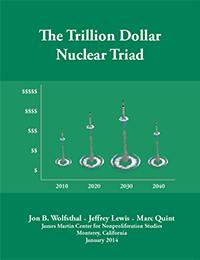Jon Wolfsthal
January 7, 2014
 The James Martin Center for Nonproliferation Studies (CNS) convened an event to release its latest report “The Trillion Dollar Nuclear Triad: US Strategic Nuclear Modernization Over the Next Thirty Years.” The report concludes that the United States will likely spend over $1 trillion during the next three decades to maintain its current nuclear arsenal and purchase their replacement systems. The necessary level of procurement spending, as a percentage of the defense budget, will peak at levels comparable to the Reagan-era build-up of nuclear forces.
The James Martin Center for Nonproliferation Studies (CNS) convened an event to release its latest report “The Trillion Dollar Nuclear Triad: US Strategic Nuclear Modernization Over the Next Thirty Years.” The report concludes that the United States will likely spend over $1 trillion during the next three decades to maintain its current nuclear arsenal and purchase their replacement systems. The necessary level of procurement spending, as a percentage of the defense budget, will peak at levels comparable to the Reagan-era build-up of nuclear forces.
To date, few senior officials from the White House or Department of Defense or in the Congress have publicly acknowledged or laid out the full scale of these costs to the American public. This lack of public debate will likely lead to sticker shock as the full cost of these programs come due, leading to budget cuts and program delays.
“The strategic and financial challenges facing our country are enormous,” said Jon Wolfsthal, CNS Deputy Director and former nuclear advisor to Vice President Joseph Biden. “Policy makers lack the basic information needed to make smart choices about our nuclear arsenal, putting both our deterrent and future reductions at risk.” The report cites particular concern over the pace of planned construction of strategic systems to replace systems that are set to retire starting in 2030. The United States plans, from 2024-29, to build five strategic submarines, 72 strategic bombers, and 240 intercontinental ballistic missiles (ICBMs). This represents more delivery vehicles than the combined nuclear forces of China, the United Kingdom, and France. It is unclear that the industrial and management capabilities in the United States are capable of this production rate in times of budget constraint.
The report relies on the government’s own budget projections, including planned investments:
- $100 billion for 100 long-range strategic manned nuclear bombers. An additional $30-40 billion will be needed to provide the nuclear weapons and cruise missiles to be deployed on these airplanes. This includes some $45 billion in previously unacknowledged funds required to build the new airplane.
- $20-120 billion for a new generation of land based ICBMs. The highest end projection includes a few tens of billions of dollars to make new ICBMs mobile or implement other exotic basing schemes—a plan considered and rejected in the 1980s because of its extreme cost, but under consideration again according to Air Force solicitations.
- Some $350 billion in funding for the National Nuclear Security Administration for maintaining current and building more modern nuclear weapons. This averages over $11 billion per year, despite Congress’s refusal to provide more than $8 billion in any of the most recent budgets.
These estimates make no allowance for additional cost overruns or delays, although defense and energy programs routinely cost significantly more than initial estimates. The report also does not try to estimate related costs that are not routinely listed within the nuclear budget, including taking apart retired systems, environmental clean up, long-term healthcare, or pensions for military servicemen, etc.
The report’s primary recommendation is for Congress to require the White House and Defense Department to annually produce an estimate that looks at the cost of maintaining and replacing strategic systems over their entire lifetimes. Current estimates look out only ten years—shortly before the largest expenditures begin in the mid-2020s. The authors propose that the Office of Management and Budget oversee preparation of a year-by-year estimate of the full life cycle costs of each major strategic system currently in the arsenal, as well as those under consideration to replace current systems.
The event also highlighted the recent publication by the Congressional Budget Office report estimating the cost of the US nuclear arsenal over the next ten years.
Media Reporting
This research report is regarded as the authoritative source on US nuclear modernization plans, and has been cited more often than two dozen times over the course of three years:
2016
- September 30: The Washington Post
- August 29: The National Interest (mention)
- August 29: World Policy blog
- August 2: Bloomberg News
- July 14: The New York Review of Books
- June 16: Huffington Post
- June 24, Mother Jones
- March 21: Moyers & Company
2015
- November 28: Politicus
- November 27: Stars and Stripes
- November 26: Eurasia Review
- August 7: Al Jazeera
- August 7: Huffington Post
- Jun 24: Reuters/Yahoo!Taiwan
- Jun 4: Centre for Global Research
- Jun 3: RIA Novosti
- Jun 1: Foreign Policy in Focus
- May 26: Pulitzer Center
on Crisis Reporting - May 22: The Washington Post
- May 7: Business Insider
- May 5: Politifact.com
- Mar 24: Sputnik News
2014
- Nov 30: The New York Times
- Nov 12: Portland Press Herald
- Jan 9: CBS News
- Jan 8: The Diplomat
